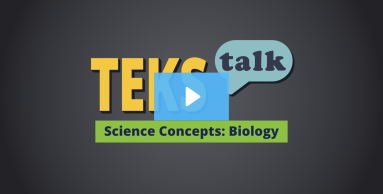
Knowledge and Skills Statement
The further explanation is designed to be a resource for educators that helps them better understand the topic their students are learning. Further explanations may be written at a more complex level than would be expected for students at the grade level.
Examples of gene mutations include point mutations, which are mutations to a single nucleotide base such as insertions, deletions, and substitutions. Insertions and deletions can be caused by a single nucleotide or a section of bases. They have a cascading effect causing a shift in the reading frame and are known as a frameshift mutation.
A substitution of one amino acid for another may affect the overall protein structure, and the enzyme produced may have a change in function. Truncating the protein early produces an incomplete and nonfunctional protein. Frameshifts in the DNA sequence make the code illegible, and if it makes a protein at all, the protein does not function as originally intended.
Research
Gonzalez, Beatriz Y., and Johannes H. van Oostrom. "Favorite Demonstration: Using Dice to Explore the Consequences of DNA Mutations." Journal of College Science Teaching 38, no. 5 (May-June 2009): 56-59. https://www.proquest.com/docview/200327345?pq-origsite=gscholar&fromopenview=true&sourcetype=Scholarly%20Journals
Summary: Working collaboratively, students explore the effect of different types of DNA mutations using dice. The exercise provides students with a tangible way of visualizing how mutations may contribute to genetic diversity and the randomness with which they may occur. After the exercise, students comprehend better why some mutations may cause devastating phenotypic effects, while others do not affect the resulting protein.
Research
Stenson, Peter D., Edward V Ball, Katy Howells, Andrew D Phillips, Matthew Mort, and David N Cooper. "The Human Gene Mutation Database: Providing a Comprehensive Central Mutation Database for Molecular Diagnostics and Personalised Genomics." Human Genomics 4, no. 1 (December 2009): 69-72. https//:doi.10.1186/1479-7364-4-2-69.
Summary: HGMD Professional remains the only comprehensive database of germline mutations in nuclear genes underlying or associated with human inherited disease. It can be used to search for newly identified gene lesions to determine whether or not they are novel. It can be searched on a gene-wise basis to obtain an overview of the known mutational spectrum for a given gene (via a dynamic mutation viewer which depicts coding region mutations superimposed on the cDNA sequence of a gene). It can also be searched for other examples of a specific type of mutation in a specific location (e.g. at position +5 to a donor splice site) to garner evidence for the pathological authenticity of a given lesion.
